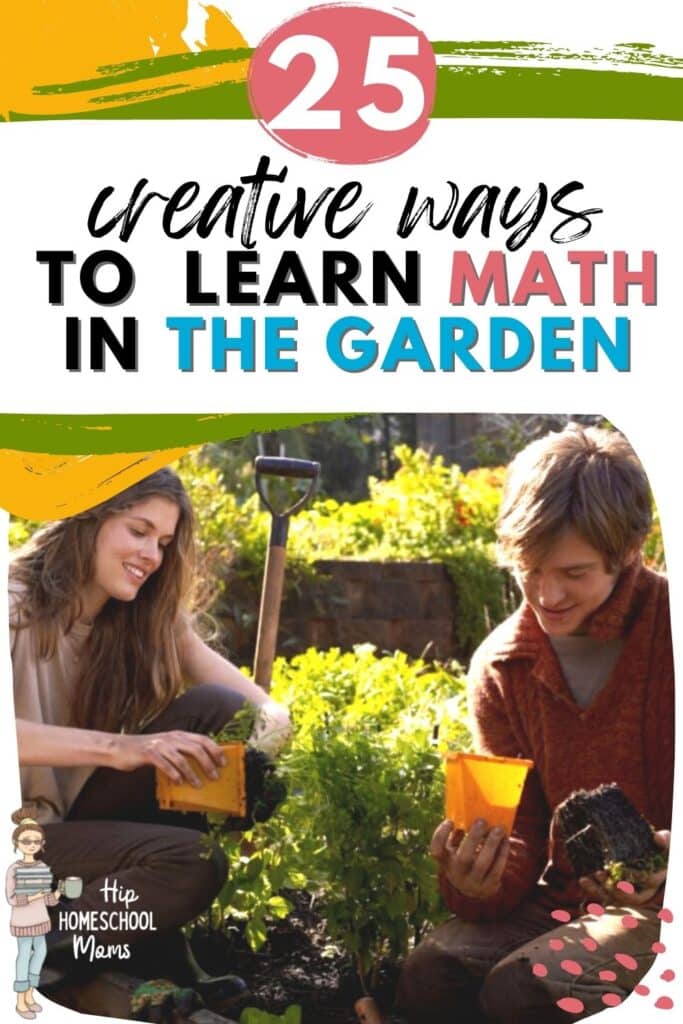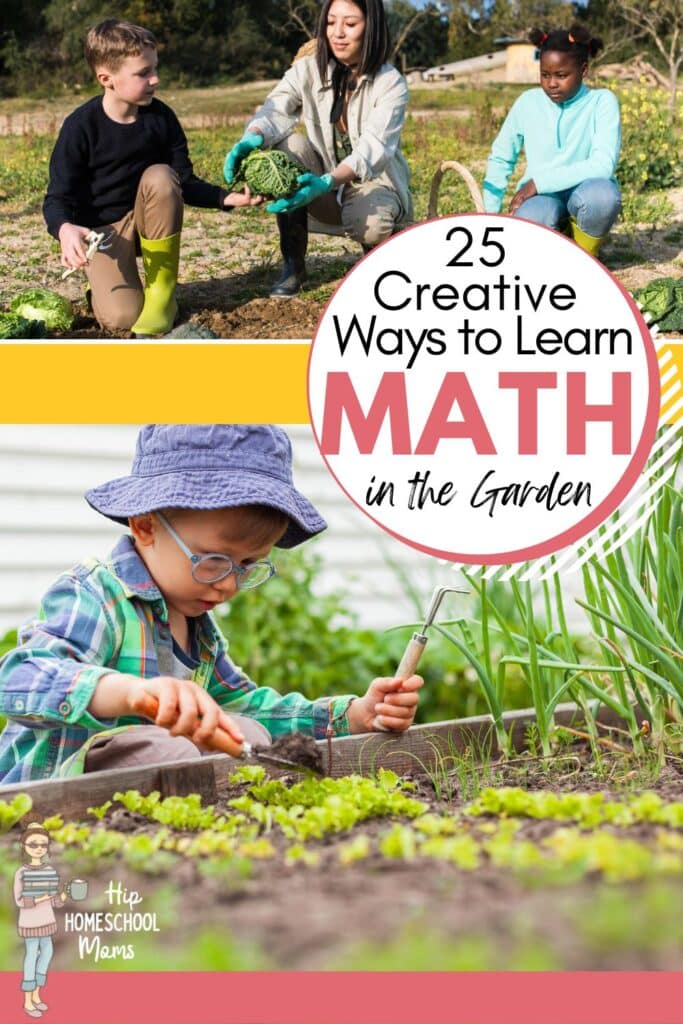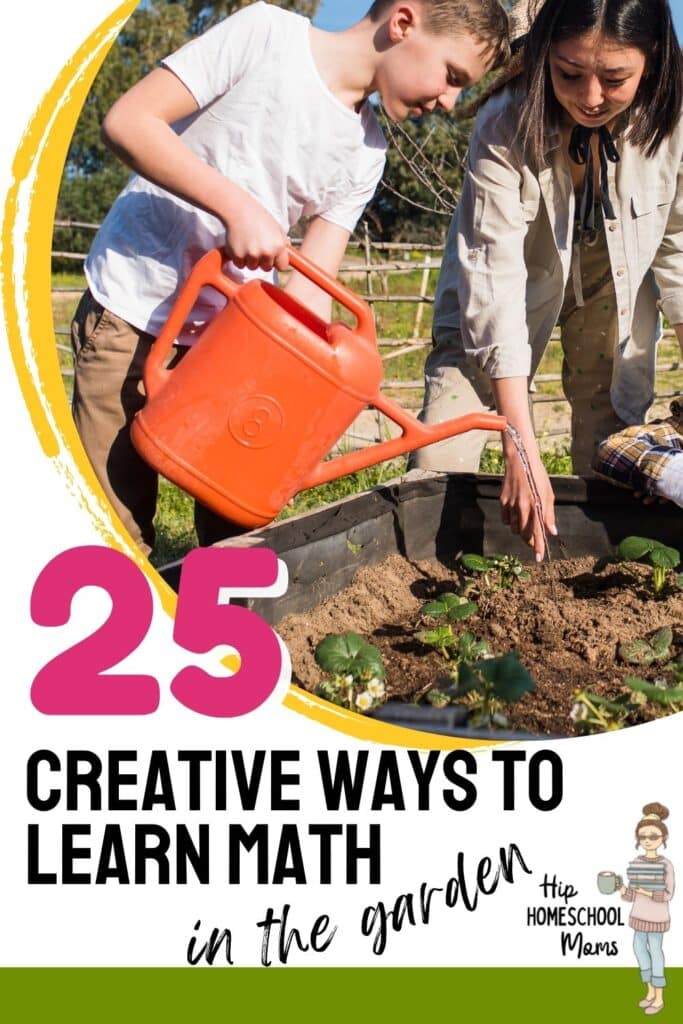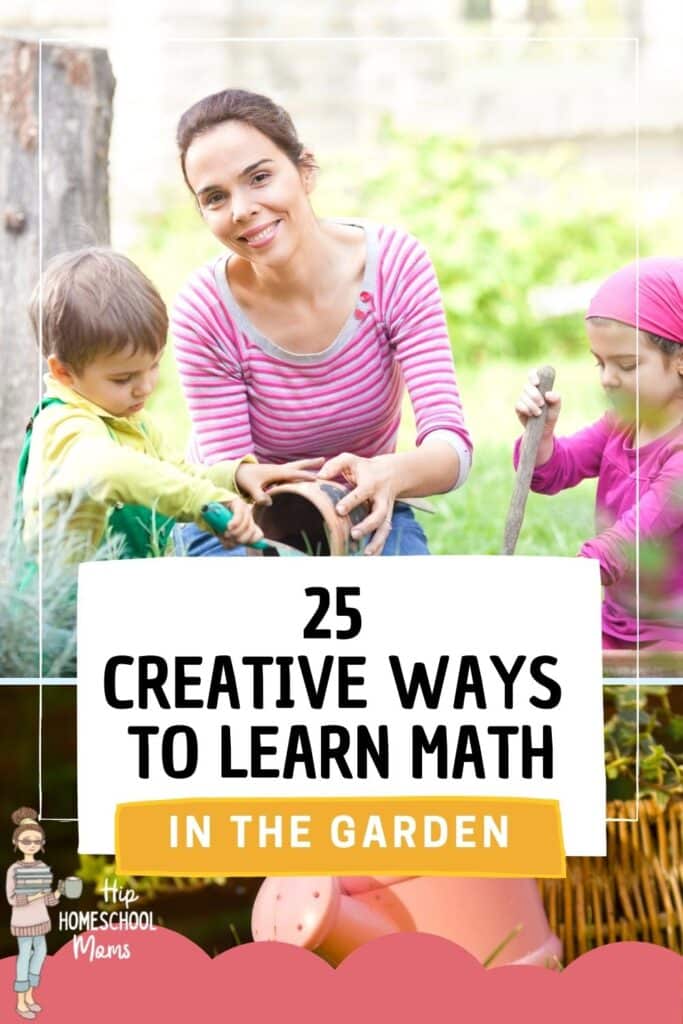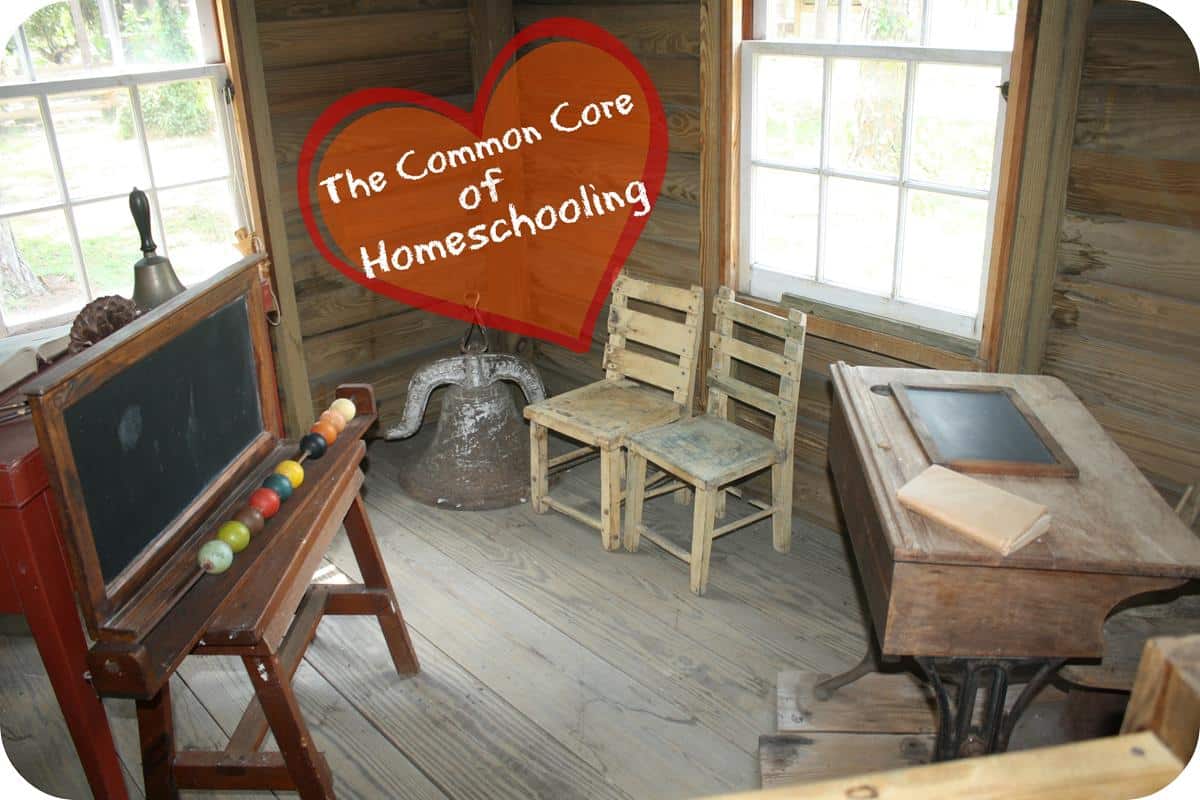25 Creative Ways to Learn Math in the Garden
I love gardening. It can be such a fulfilling way to connect with the natural world. (Plus, with the cost of groceries these days, many of us are becoming more interested in growing our own food!) But the garden can provide more than just food for homeschooling families. It can also provide a great way to teach children about subjects such as botany and science. More than that, you can have fun teaching your kids math in the garden!
No matter what math level your homeschooler is working on, math often comes more easily with those visual and kinesthetic examples that help it to really “click.” And the garden is a wonderful place to integrate math skills and daily life in a hands-on way that produces lasting memories–and some pretty flowers or delicious vegetables, too!
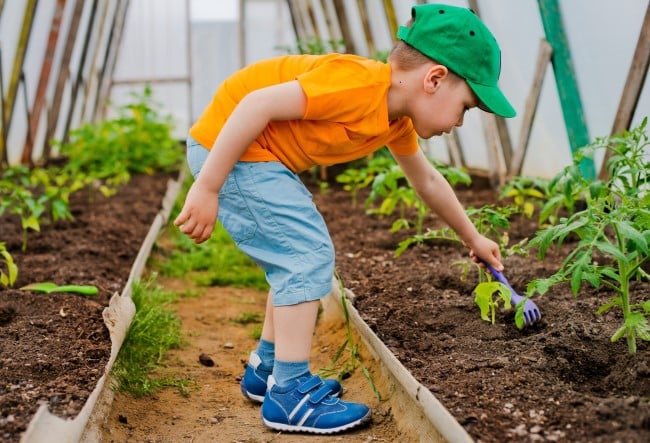
Whether your child(ren) is just learning to count, or working on algebraic concepts, there are plenty of ways you can incorporate some entertaining yet educational lessons of math in the garden. Having a blast creating a hands-on math lab with some of our ideas for different levels of learning. We hope you’ll be inspired to go out in the sunshine and get your math groove on. (And seriously, what kid doesn’t love to get their hands in that glorious dirt?)
Before jumping into a variety of fun ways to teach math in the garden, I want to introduce an amazing math curriculum that actually worked for our homeschooling family, CTCMath. It has made a huge difference in approaching the often-intimidating subject of math in a whole new way.
If your children feel overwhelmed while tackling math, please don’t wait to check out this math curriculum. Math can be frustrating, to say the least, and you don’t want that frustration to rob your children of the confidence they sorely need. You want your kids to believe that they can do it. If they are struggling, check out CTCMath today! They have a free trial and a 365-day money-back guarantee, so you have no reason not to try it out.
How to Teach Your Kids Math in the Garden
For young learners (Pre-K through elementary level learners):
If you have young children, you can find very simple ways to connect their love of the outdoors with early mathematical concepts. The beauty of this, as with many hands-on homeschooling experiences, is that you don’t have to force anything or make it seem too “math-y!” Mathematics is a natural part of planning and harvesting in a garden. You just have to make that extra effort to communicate about what’s already there!
Before you get started, you’ll probably find it helpful to build a collection of gardening tools. That way, you won’t waste precious time learning about math in the garden while you’re searching for gloves or a spade or watering can. Here are a few basic gardening implements you’ll want to have from the get-go:
A kids’ garden tool set is a must-have for younger children. They’ll enjoy having their own tools to use in the garden as they work alongside you. They also have the opportunity to learn to be responsible for their personal gardening tools.
Vegetable and herb seeds are a necessity for your homeschooling adventures in the garden. You can get a huge supply of non-GMO seed packets, with over 40 different vegetables and herbs your family can grow on your own.
If growing flowers in your garden is more up your alley, you might want to start with a variety of perennial flower seeds. Perennials endure year after year, so you don’t have to start afresh each year as you would need to with annuals. Of course, having some annual flower seeds or a combination of perennials and annuals can be helpful as well, giving your student something to plan out each spring as part of your math in the garden curriculum.
Gardening buckets will come in handy for transporting soil, fertilizer, or mulch.
Your child will surely enjoy having a wagon or a mobile gardening caddy for keeping supplies together as they transport them from one place to another. There are options for young children, wagons that come with gardening tools, as well as sturdy wagons for older students and adults to use.
If your student is in middle grade or high school, they might prefer using adult-sized gardening tools as they work. The kiddy size will likely prove to be too small or flimsy for them.
Activity Ideas for Learning Math in the Garden
Okay, let’s get right into some specific mathematical concepts you can emphasize as you enjoy learning math in the garden with your young learner.
- What shape will your garden area be? This gives you an opportunity to discuss basic shapes and geometry with your young learner.
- What size will the garden be? As you talk about size, you can discuss basic units of measurement such as inches and feet (and their relationship to one another). Your young learner can even help you measure out the height and width with you, giving you a chance to discuss perimeter. You will also want to discuss where different gardening plots will be in relation to one another, as well as to other things on your property. This can prompt other things to measure and incorporate into garden planning. For instance, how far do you want your garden to be from your house, a body of water, a chicken coop, etc.?
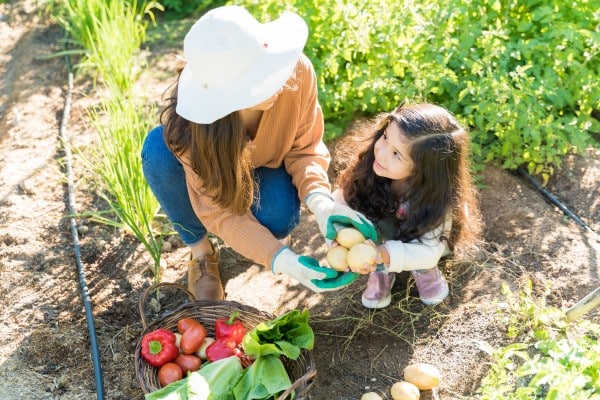
- If you’re building garden boxes, you’ll want to make sure the ground, walls, and supports are level. Use a leveling tool to teach your child how to determine if things are level.
- Use graph paper to plan out a garden using the shapes and measurements that you and your child(ren) have determined! Don’t forget to show where the garden will be on your property by including other landmarks. This is a chance to use math skills, while also getting creative and excited about your garden!

- Counting, addition, and subtraction can all be easily integrated into planting and cultivating a garden! For example, you can have your child count the seeds in a packet, and count how many are planted. Your child can practice writing numbers and make a record of how many of each type of seed have been planted. When the seeds begin to sprout, the child can record that, too! This data can be used to create simple word problems, for example: “If 50 seeds were planted, and 35 sprouted, how many seeds did not sprout?”
- Research the watering requirements for your fruit, veggie, and flower plants. This is a great chart-reading activity. Then, have your kids keep a rainfall chart. For older students, have them measure and install and simple water drip system.
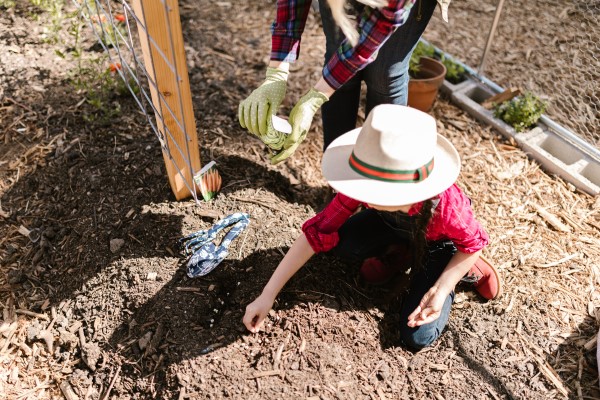
Garden Math Activities for Older Learners (upper elementary through high school)
For older, or slightly more advanced learners, you can still discuss all of the above concepts as you learn about math in the garden! As your homeschooler(s) starts to delve into more complicated math concepts, there are also plenty of ways to use the garden as a hands-on math lab to explore those, too!
If any of these more advanced math concepts are something you or your students struggle with, I encourage you to find a math program that works in tandem with your child’s capabilities. As a homeschooling parent, you want your child to feel successful at math, and CTCMath can help with just that!
CTCMath can be used in tandem with your hands-on math in the garden experiences. Because all levels are included, if your children encounter a concept they do not understand, they can always head straight to the lessons that build the foundation for that concept. You don’t have to worry about how long it takes to learn some math concept, focusing instead on your child learning to master it. And remember, if you sign up for the free trial, they also have a 365-day money-back guarantee.
- Slightly older learners can find even more ways to explore geometry through gardening! As with younger students, you can still discuss various shapes when planning a garden. With older learners, you can also expand on this by asking your homeschooler to use perimeter, circumference, and area formulas for different shapes that may be used in a garden.
- Building off the last point, you may want to give your older child license to plan a section of the garden before getting his or her hands dirty! This could be at a more detailed level than what you’d ask of a younger child. For instance, older students can plan a garden using geometric formulas and measurement skills. Have your homeschooler use graphing paper to plot and plan different shapes for the garden (including the formulas used)!
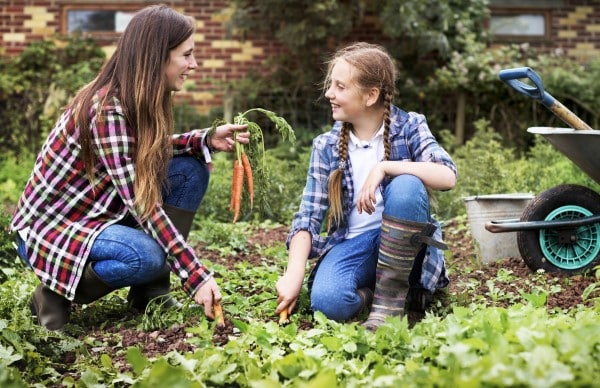
- Estimation is another important math skill that learners of all ages can use when gardening. Have your learner keep track of seeds planted, make predictions/estimations about yield, and track the progress. This is another area in which graphing could help your student keep track!
- Charts and graphs can also be incorporated in a huge variety of ways throughout the gardening process (not just for planning). For example, you may want to use a graph to show which plants need watering (and how much.) This can also be helpful if you have more than one person responsible for the garden; that way nothing gets over or under-watered! Or you can create a graph or chart that shows the difference in how you plant certain seeds. This type of graph may include information such as: when do different plants need to be planted? How far apart do the seeds need to be from one another? How deep do they need to be planted? Once your plants are growing, you can also have your child(ren) create charts that show data like germination, growth, and yield. Creating charts or graphs can keep all of this information in one place, all while using key math skills!
- When planning a garden, have your children research plants you’re going to put in and keep a notebook. They can record how big mature plants typically grow, how far apart to plant, etc. Here is an affordable bundle of notebooking activities and pages.
- Estimation is another important math skill that learners of all ages can use when gardening. Have your learner keep track of seeds planted, make predictions/estimations about yield, and track the progress. This is another area in which graphing could help your student keep track!
- Charts and graphs can also be incorporated in a huge variety of ways throughout the gardening process (not just for planning). For example, you may want to use a graph to show which plants need watering (and how much.) This can also be helpful if you have more than one person responsible for the garden; that way nothing gets over or under-watered! Or you can create a graph or chart that shows the difference in how you plant certain seeds. This type of graph may include information such as: when do different plants need to be planted? How far apart do the seeds need to be from one another? How deep do they need to be planted? Once your plants are growing, you can also have your child(ren) create charts that show data like germination, growth, and yield. Creating charts or graphs can keep all of this information in one place, all while using key math skills!
- Use advanced math to calculate the materials you’ll need! For example, your homeschooler can figure out how much soil will be needed in different gardening beds by calculating the volume. Are you building a garden box? Start with the perimeter and then figure out how much material you will need to build a box of the depth and width you want to create! You could even get really advanced and use algebra to calculate the seeds needed to cultivate the area of a given plot.
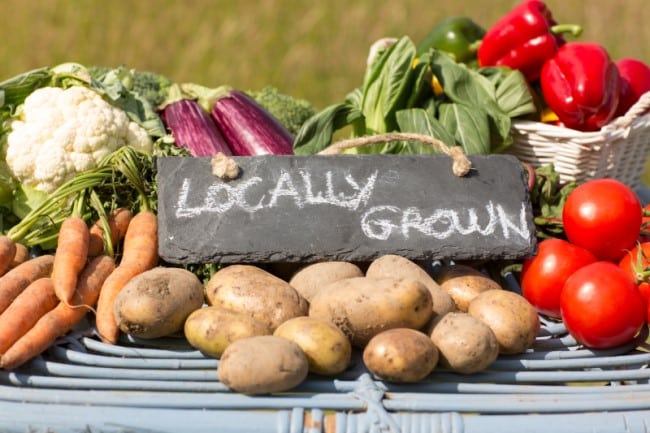
- Are you growing enough vegetables to sell at the Farmer’s Market, at your co-op, or among friends? Entrepreneurship and business finance are exciting ways to give your older child some hands-on learning experiences when it comes to mastering math in the garden. After establishing the gardening budget and counting an inventory of the harvest, have your child figure out how vegetables will need to be priced in order to achieve a realistic profit! You may want to come up with some hypothetical questions (AKA “word problems”) to help your learner along. This lesson comes with built-in, monetary motivation for older homeschoolers looking for a side hustle.
- Throughout the growing season, keep a photo log of the different insects spotted in your yard and garden. Then, make a chart of the number of beneficial insects vs. the number of pests that destroy plants.
- Assign each of your children to an area of your yard or garden. Have them tally up how many bees and butterflies they see during a set period of time. (You may want to include other insects.) Then, compare results. Do this once a week for a month and compare the numbers across weeks. Take the math further and have them calculate the average number of bees found per observation period; repeat for each insect tracked.
Study Math in the Garden Throughout the Year
Gardening doesn’t have to be only a spring or early summertime homeschooling activity! Here are some terrific ways you can enable your students to learn math in the garden, and other subjects too, throughout the year:

- Incorporate literature and reading into your gardening adventures with Books about Gardening for Kids. For some kids, reading about the garden might be more along their line of interest. (You know, the rare ones who don’t like to get their hands right in the soil.) Adding some educational books about gardening to your homeschooling curriculum will give you a more well-rounded approach.
- During harvest season, keep track of the biggest and heaviest tomato or squash plant grown in your garden! Using a measuring tape and food scale, have your children chart the circumference and weight of the tomatoes harvested. This helps build measuring and charting skills.
- Use your fresh grown vegetables and fruit to make a recipe. For example, if you’re making spaghetti sauce with fresh tomatoes from your garden, have your kids cut and measure out the tomatoes.
- As you begin gathering fruits and vegetables, teach your kids about Seed Saving. They will be excited about the opportunity to collect seeds and save them for the next year’s planting activities. This can also lead straight into a discussion about Plant Life Cycles.
- Research the fall and winter temperatures in your area. This is another great math activity to help your student build chart-reading skills. Next, research cool or cold weather plants and write down their temperature and water requirements. Next, compare those numbers to the average temperature and precipitation where you live. What, if any, crops will grow during cooler months?
- Build a small indoor grow light area. Measure out the area needed? Make a list of materials and write down the prices for what is needed to build the system.
- Plan how you will remediate and prepare the garden soil for the next growing season. If you are going to amend the soil, how many bags or square yards of material will you need? How much will it cost? There is definitely more advanced math with these projects–perfect for upper grades.
Learning math in the garden can be an important part of the hands-on aspect of teaching math using CTCMath. We hope this article has inspired you to think about unique ways to incorporate math into the important skill and hobby of gardening. A variety of gardening skills can align perfectly with a math curriculum like CTCMath, which is designed to take the frustration and intimidation out of math for your child and for you.
Be sure to use our special HipHomeschoolMom’s link to get a deep discount. (We hope you love the fact that CTCMath is one price for the entire family.
We hope these ideas help you think of new and exciting ways to bring your own, unique math lab to life as you cultivate your garden! Do you have any mathematical gardening tips to add to this list? Drop a comment and let us know!


